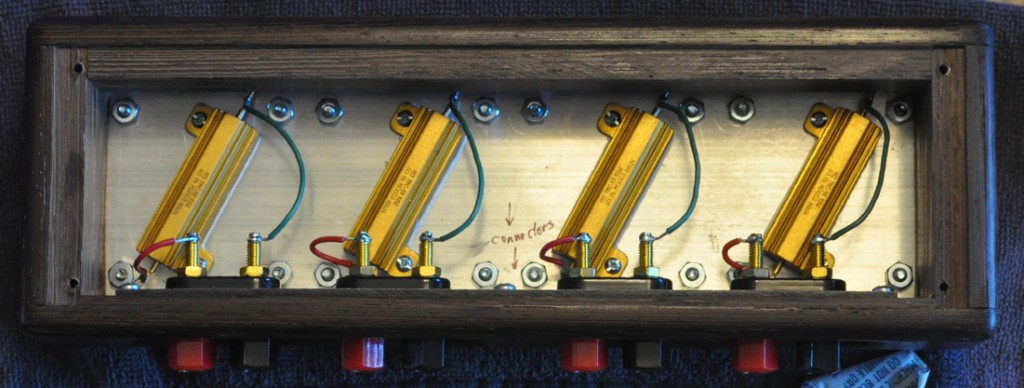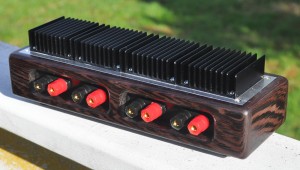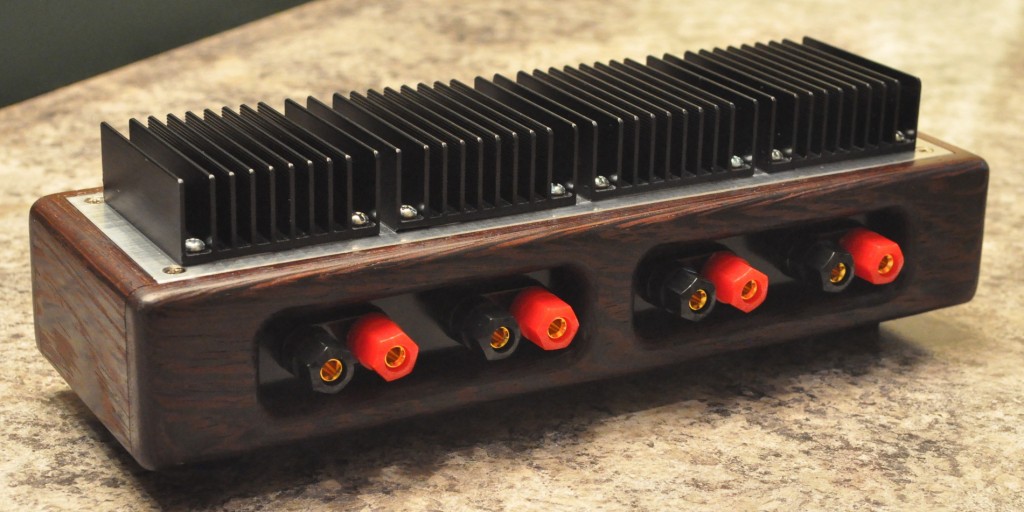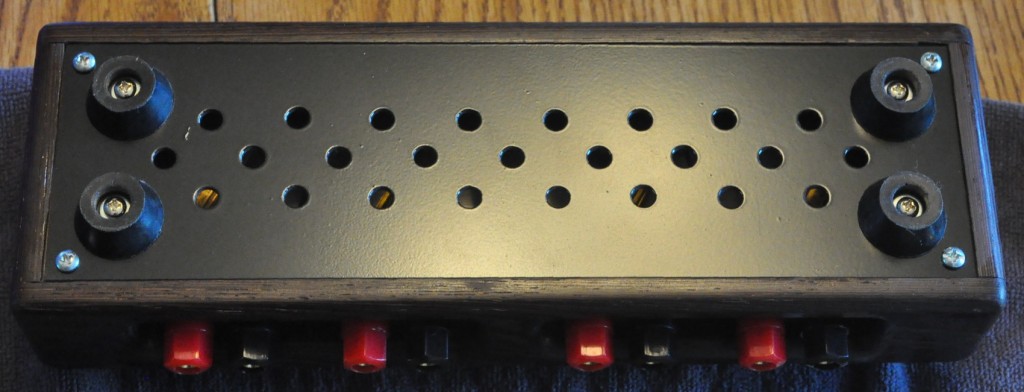A Proposition
Just because something is a piece of test equipment doesn’t necessarily mean that it has to look like a piece of test equipment. This proposition is where I started with this particular project. I have a couple of amp projects in progress and was thinking forward to testing as I was putting the chassis together. In the past I’ve just wired some power resistors across the output terminals for testing and called it good. But, as I looked at a piece of heavy aluminum plate stock sitting on my workbench, I decided that I could do better; and make it look better at the same time. Thus was this project born.
Project Simplicity
Technically, there really isn’t much to this project. It’s just four 50W 8Ω power resistors (derated to about 22W each in this application), four heat sinks, four connectors, some aluminum, and some wood. What could be simpler? The key here was materials and layout. As I indicated above, the top plate is made from a piece of 1/4″ think, 3 inches wide plate aluminum cut to 10-1/2″ long. The nice thing about this stock is that it is thick enough to allow the power resistors to be mounted with 1/4″ long screws in tapped holes, and yet still allow the heat sinks to sit flush on top. Here is a picture of the entire “heat sink unit” all assembled.
 Here the heat sinks are on the top of the plate; held in place by four 6-32 screws each. The power resistors are mounted to the underside, one under each heat sink, with 1/4″ 4-40 screws into tapped holes. I have left the plate without paint or finish for good heat transfer. The undersides of both the power resistors and heat sinks have a good even application of a heat conductive grease.
Here the heat sinks are on the top of the plate; held in place by four 6-32 screws each. The power resistors are mounted to the underside, one under each heat sink, with 1/4″ 4-40 screws into tapped holes. I have left the plate without paint or finish for good heat transfer. The undersides of both the power resistors and heat sinks have a good even application of a heat conductive grease.
The wiring is Just a s simple as the heat sink. Just eight wires to connect the four load resistors to the four connectors. The reason for four loads is simple. depending on how the loads are wired, it will provide 4Ω, 8Ω, or 16Ω stereo loads. This is more than sufficient for my purposes. Here is a picture of the internal wiring.
 As can be seen from the wiring, each load is completely independant. This means that testing stereo amplifiers with global feed back (where feed back may be from either side of the output transformer depending on the number and type of amplifier stages) will not be an issue.
As can be seen from the wiring, each load is completely independant. This means that testing stereo amplifiers with global feed back (where feed back may be from either side of the output transformer depending on the number and type of amplifier stages) will not be an issue.
One important thing to remember is that the derating of the resistors is dependent on the ambient temperature where the resistors are located. This means that it is critical to vent the enclosure to help prevent heat build up. Here is a picture of the underside showing the venting holes.
These 25 holes are the equivalent of a 1.2 square inch hole in the base plate. This should be more then sufficient to keep it from getting too hot inside the chassis.
The Results
 It was not the most complicated or difficult thing I’ve ever built, however I am pleased with the results. The chassis was made from a scrap of 3/4″ thick African Wenge wood with a couple of coats of oil applied and polished. With the very dark wood, the black heatsinks, and the accent of polished aliuminum on top, I think it looks pretty good.
It was not the most complicated or difficult thing I’ve ever built, however I am pleased with the results. The chassis was made from a scrap of 3/4″ thick African Wenge wood with a couple of coats of oil applied and polished. With the very dark wood, the black heatsinks, and the accent of polished aliuminum on top, I think it looks pretty good.
This simple little unit will give me years and years of service on my test bench. And it will never look like something I just cobbled together. So I guess the proposition with which I started is true after all.
Just because something is a piece of test equipment doesn’t necessarily mean that it has to look like a piece of test equipment.
17 May 2024: There is a more in depth description of the unit, the construction, and the derating of the loads at the following link: Speaker Load Box



I know this is old, but how does one determine the correct wattage for the dummy loads?
Ideally, they should be able to dissipate the power of the most powerful amp you are likely to test. If that is a 20 w/channel amplifier then 20W (appropriately derated) should be sufficient. However, if you don’t think you’ll be testing at full power, then a handful of watts should suffice. There is a posting with much more detail of how the project was designed and produced at the DIYAudioProjects website at this link.
Great design and I thank you for sharing.
Pingback: A Lesson in Chassis Building | Cascade Tubes
Hi Matt,
Love the design. Pardon the novice question here. So if I wanted 16ohm load I would connect two of the 8ohm resistors in series using banana plugs? Where would you insert a scope or meter to test measurements?
Thanks
Jeff
Jeff; Yes you’re correct. For a 16Ω old just put two resistors in series. As to where to attach test leads, this really depends on what you have. Personally I like stackable banana plugs, but because these are 5-way binding posts, you can also put a wire under the post and still insert a banana plug. Also, if you have uninsulated banana plugs (i.e. the long ones) you can clip an alligator clip to the part of the banana plug that is exposed. Like I said, lots of options depending on what you have.
Perfect! Thanks for the awesome idea and plan. I was thinking about doing this with a switch and using 3, different value resistors(16,8,4 ohm) Your design seems more flexible.
Hi, Matt,
Thanks a lot for sharing your knowledge here.
Probably a stupid question, but just to check it: I understand that this is to replace the real speakers to test an amp. So you have there room for 4 “speakers”, right? I mean that to test just two speakers it would be sufficient with half the device.
Am I right?
Thanks in advance.
Yes. Provided that the load resistors match the output impedance of the amplifier under test (e.g. 8Ω amplifier output impedance and 8Ω load resistors) you could just use two resistors.
However, one of the nice things about having the four loads is that, depending on whether one or two resistors are used, the load can be 4Ω, 8Ω, or 16Ω. These are all common output impedances and the load can generate these loads for two channels simultaneously. Also, using three or four resistors (so you’ll only get one load channel) you can get 2Ω, 2.6Ω, 3.2Ω (common in small guitar amplifiers), 5.3Ω, 6Ω (a very common output impedance), 24Ω, or 32Ω.
So having four separate loads, while it could allow four channels to be loaded simultaneously, is really about added versatility to test a wide range of audio amplifiers. Does this answer your question?